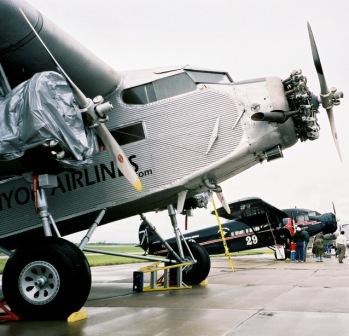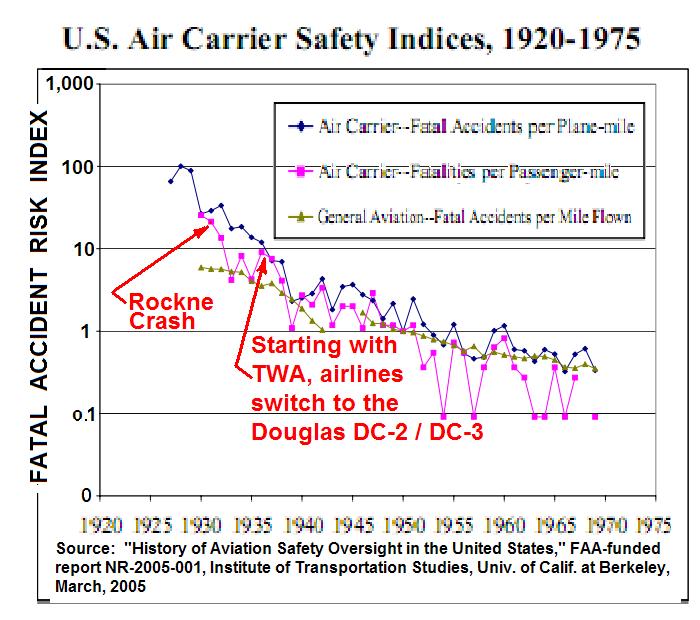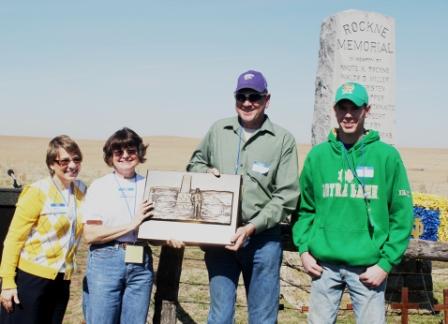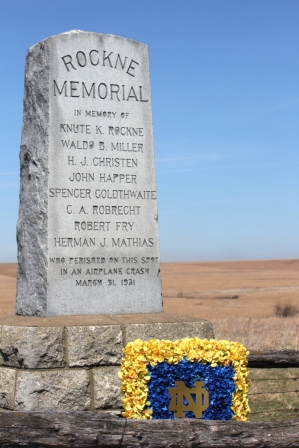
Fans, Family Remember
the Crash Heard 'Round the World 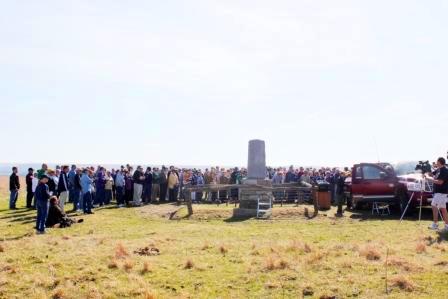
Crowd commemorates the life and death of football legend Knute Rockne and 7 other victims of the 1931 crash in the Kansas prairie... that forever changed aviation.
|
Copyright 2011 by Richard Harris
Event photos courtesy of Dennis Kelly
For additional pictures, including original crashsite photos, visit this special web page of kanasphototour.com .
BAZAAR, KANSAS, USA -- Saturday morning, April 2nd, 2011, over 150 people
from around the nation gathered in a remote Kansas prairie field to commemorate
the infamous, pivotal 1931 airplane crash, here, that killed 8 people 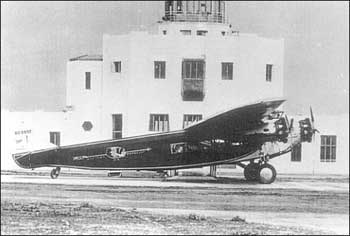 -- including one of
the most beloved Americans of his time, Notre Dame football coach Knute Rockne
-- a tragedy that triggered a worldwide revolution in aviation.
-- including one of
the most beloved Americans of his time, Notre Dame football coach Knute Rockne
-- a tragedy that triggered a worldwide revolution in aviation.
On a dreary spring morning, March 31, 1931, despite the threat of icing in the clouds, Transcontinental & Western Airlines (TWA) Flight 599, a primitive Fokker F-10A tri-motor airliner, carrying Rockne, five other passengers, and a crew of two, took off from TWA's new home base in Kansas City.
(Half a century later, a TWA mechanic would report he had warned against it, because parts of the wooden wing were coming unglued internally, due to moisture.)
Enroute to a mail-stop at Wichita, the plane was to continue on to Los Angeles -- where Rockne had a rendezvous with Hollywood.
But in the air, something happened -- apparently the wing's wooden main girder (the "spar") -- snapped. Whether it was a result of an ice-induced loss of control, or simply the structural rot found later in the wreckage -- the wing separated and the plane plummeted into a remote prairie pasture, straight into the ground, killing everyone instantly.
The crash was only one of many airplane crashes in the early years of commercial aviation, a daring and dangerous business at that time (one statistic indicated airline passengers of the time were hundreds of times more likely to die in a crash than train passengers).
But, in killing all eight people aboard, this crash was one of the very worst airplane crashes in history, up to that time, and shocked the nation. And the loss of Rockne, a national hero, made this a turning point: It was a crash that emotionally affected millions of people.
So this historic disaster focused intense national attention on the problem of safety in the skies -- forcing radical
changes in aircraft creation and use, while forcing far greater government
involvement and transparency. The result: a fundamental revolution in the
quality, safety and viability of air travel, in America and throughout the world. 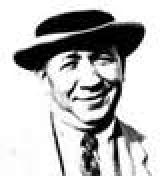
A NATIONAL HERO
In the depths of the Great Depression, Norwegian-born Knute Rockne was a
beloved American national icon unlike any other in the history of sports -- not
just the winningest coach in the history of the game (before or since), but far
more. In the 1920s, and into the Great Depression, Rockne, Notre Dame's
pioneering football player-turned-coach -- who promoted sportsmanship,
citizenship and intellect as surely as victory -- was revered nationwide as
THE American icon of honorable strength, toughness, and success. His
legendary inspirational speeches were widely quoted, and Rockne became, in a
sense, both a national hero and the nation's moral philosopher. 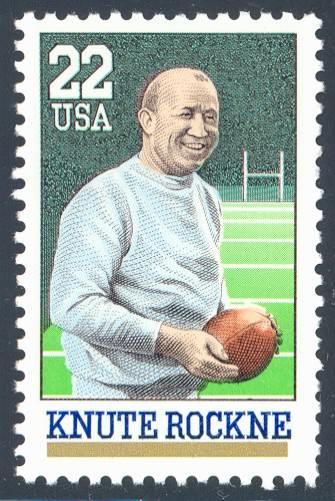
(A popular movie about him -- "Knute Rockne, All American" -- starred Ronald Reagan, in that future president's most famous Hollywood role, as Rockne's famed best athlete, George Gipp, "the Gipper"... Reagan's future nickname.)
So the deadly crash, snuffing out the lives of 43-year-old Rockne and the others, was a spectacular, earth-shaking tragedy -- "a national loss," said President Herbert Hoover -- that played out in the national press for months in the Great Depression.
Like the later disappearance of Amelia Earhart, the kidnapping of Charles Lindbergh's baby, and the assassination of John F. Kennedy, the Rockne crash evoked great horror, anxiety and grief in the American population -- triggering a national obsession with getting "answers to the mystery," and a national outcry for actions that could "ensure that this will never happen again."
|
THE REVOLUTION
The Rockne crash became an earthquake that shook the foundations of Amercan aviation -- ushering in sweeping fundamental changes to safety regulation, more careful accident investigation and the first-ever public reporting of the government findings.
With the government investigators throwing out one desperate guess after another about the cause, and each turning out on further evidence to be uncertain or false, the credibility of the investigations unraveled. They were further undermined by suspicions of excessively collegial relations between the regional office of the federal aviation regulator and the airline (TWA) it was supposed to be overseeing.
From this controversy grew the now-accepted notion that aviation crash-investigation responsibility should be assigned to an independent agency separate from the federal aviation oversight agency (back then the Bureau of Air Commerce, rough equivalent of today's Federal Aviation Administration), to avoid any appearance of a "cover-up" of official mistakes that may have contributed to a crash. (Today, that responsibility rests with the NTSB -- National Transportation Safety Board -- an investigative agency independent of the FAA, Dept. of Transportation, or any other agency or department.)
Most importantly, the tragedy triggered fundamental changes in the design,
construction, maintenance and operation of airliners.
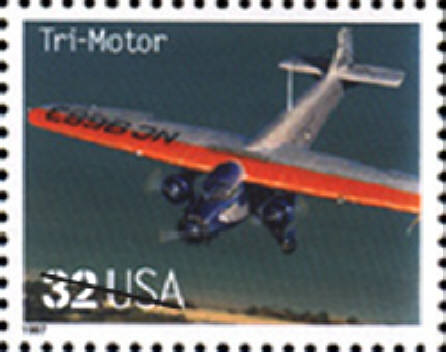 First, it initiated an
almost-overnight switch from traditional wood-framed airliners to all-metal
planes (particularly the Ford TriMotor). And within just 5 years, it had
resulted in the development of truly safe, comfortable, efficient, speedy and
reliable modern airliners -- by Boeing, Douglas, Lockheed and others.
First, it initiated an
almost-overnight switch from traditional wood-framed airliners to all-metal
planes (particularly the Ford TriMotor). And within just 5 years, it had
resulted in the development of truly safe, comfortable, efficient, speedy and
reliable modern airliners -- by Boeing, Douglas, Lockheed and others.
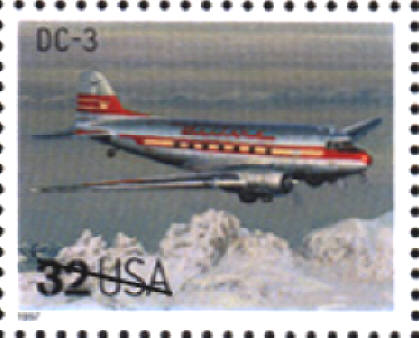
In particular, it led to TWA (Transcontinental & Western Air, later TransWorld Airlines), one of America's largest airlines, promptly demanding from manufacturers a far, far better airliner -- ultimately resulting in the creation of the most important plane in world aviation history: the Douglas DC-3, the decisive forerunner of today's modern airliners.
|
TWA's demands of the airplane industry, in response to the Rockne crash, resulted in the DC-2, which soon evolved into the historic DC-3. About 50 miles-per-hour faster than the 110-120 mph Fokker and Ford TriMotors, and able to carry nearly twice as many passengers for only a little more expense, the DC-3 was a revolutionary model of profitability, reliability and safety -- and was quickly adopted by airlines everywhere around the world, triggering a global explosion in air travel, while revolutionizing the safety of flight.
As a result of these responses to the 1931 prairie crash, aviation changed -- from rare, expensive, uncomfort-able and dangerous -- to safe, comfortable, affordable, and common. Airline travel, worldwide, underwent an explosive growth, to seven times as much passenger traffic within just a half-dozen years of the crash -- while fatal risks dropped to a small fraction of the risk that Rockne and his fellow passengers had faced.
This revolution sparked the half-century rivalry between Douglas and Boeing -- each working hard to better the other -- driving the explosive growth of these two families of American airliners into eventual world dominance, for the rest of the 20th Century.
NOW
The 1931 tragedy is marked by a towering marble-and-limestone monument at the
site, and a massive mural and historical display at the nearby Matfield Green
rest stop on the Kansas Turnpike.
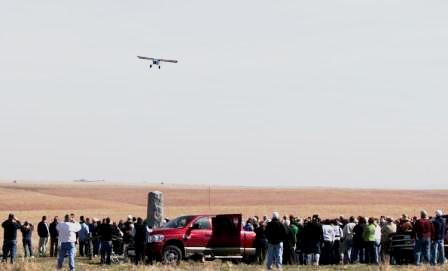
Every 5 years, a commemoration at the crashsite, and in nearby Bazaar, honors Rockne and the others, drawing people from around the country -- coming to remember that hero, his loss and the loss of the others, and take solace in the recognition of how it changed America and the world forever.
This year is the 80th anniversary of the crash, near Bazaar, Kansas. In remembrance, on the morning of Saturday, April 2nd, a commemoration included tours of the site by dedicated, knowledgeable locals (including the children of the first people at the scene of the disaster), speeches, the wailing of a bagpipe, and a low flyover by a local pilot at the same minute as the 1931 crash.
The crowd then retired to the the nearby Bazaar, Kansas schoolhouse for presentations and remembrances by Notre Dame alumni (including former College Football Hall of Fame manager,
|
THE KEEPER OF THE WATCH
Also commemorated was a special local citizen, Easter Heathman, who -- as a fourteen year-old farm boy -- had been among the first to arrive at the catastrophe, powerless to help the already deceased victims, and traumatized by the grim horror. It was Easter who would erect and maintain the crashsite monument to the victims, and for the rest of his life, until his death in 2007, bear the awful burden of being the chief local historian of the tragedy -- recalling, faithfully and humbly, whenever asked, the most horrific memory of his young life.
And, year after year, decade upon decade, Easter served as perpetual kindly host to the crash victims' many survivors and admirers, when they came looking for the past.
Before his death, a grateful Notre Dame honored Easter before a crowd of 50,000, and awarded him their highest sports honor -- an honorary letter -- as the vast crowd chanted his name throughout the Notre Dame arena.
|
Every five years, honoring their legendary hero Rockne, Notre Dame faithful and other Rockne lovers -- along with relatives of the six other victims -- gather from throughout the nation, at Bazaar, for the remembrance. This year was the first without Easter Heathman -- but his neighbors, friends and especially his family and old dog, Daisy, were there to carry on his service tradition, hosting the 5-year event once more.
And that day (as every day, now) high overhead, dozens of giant jetliners continued to criss-cross the Kansas prairie, carrying thousands of people to places far and wide -- swiftly, surely, safely -- by the safest mode of travel today: airlines.
For a detailed bibliograhy, with extensive additional quotes and information, click here.
To offer comments, corrections or information, office@harris1.net.
Based in Wichita, Kansas -- the "Air Capital City", where more airplanes have been built than in any other city in the world -- Richard Harris is a former aeronautics instructor and pilot, with a broad background as an aviation industry worker, writer, analyst & historian. A formally trained journalist, Richard has reported on the industry for national and international aviation magazines. As member of the American Aviation Historical Society and speaker for the Kansas Humanities Council, Richard has chronicled the history of major aviation developments, lectured on aerospace history at universities and museums, assisted with FAA and NASA public information programs, and provided aviation history research and narrations for documentary films and TV programs.)
Last updated March 20, 2016
Last edited March 29, 2016
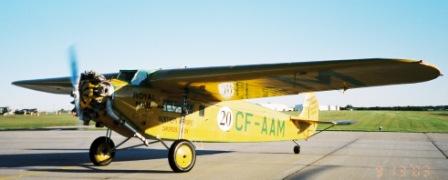
 Add a motor under
each wing, and you have a Fokker Tri-Motor -- like TWA Flight 599. (U.S.
Army photo)
Add a motor under
each wing, and you have a Fokker Tri-Motor -- like TWA Flight 599. (U.S.
Army photo)
